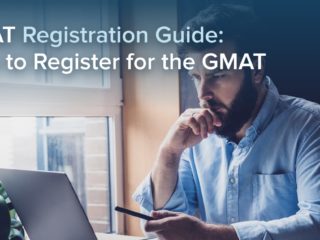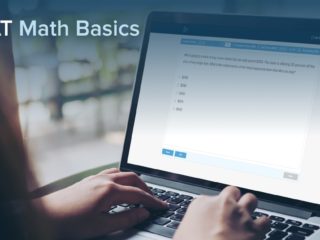| Getting your Trinity Audio player ready... |
It’s likely that you have encountered a question on a test or quiz that specifies, “round to the nearest integer,” or even worse, “round your answer to the nearest thousandth.” Facing a rounding task might make you wish you had paid more attention in math class in the seventh grade! Learning decimal rounding rules is an important skill, and it’s quite important for getting a great score on the GMAT Quant (or Quantitative) section. For example, you may encounter a GMAT Quant question asking you to round your answer to the nearest integer. If you don’t know how to round correctly, you could very well miss the question.
In this article, we will look at the rules for rounding off decimals with explanations and lots of examples. The topic is covered in full in our Target Test Prep GMAT self-study course.
Here are the topics we’ll cover:
- Rounding and Integers
- Rounding to the Nearest Integer
- How to Round Decimals
- Summary
- Frequently Asked Questions (FAQ)
- What’s Next?
Let’s start with some important definitions.
Rounding and Integers
The most straightforward type of rounding question asks you to round to the nearest integer. To get the right answer, you must first know what an integer is.
Definition of an Integer
Our basic definition of an integer is a number that can be written without a decimal point or a fractional component. For example, -62, -17, -2, -1, 0, 6, 95, and 230 are integers.
Numbers that are not integers include 1.34, -2/5, 0.8, and π.
KEY FACT:
Integers are numbers without a decimal or fractional component. Integers can be positive, negative, or 0.
Let’s consider some important terms about integers. First, the positive integers include only those integers greater than or equal to 1. They are 1, 2, 3, …
The negative integers include only those integers less than or equal to -1. They are -1, -2, -3, …
It is important to remember that 0 is neither negative nor positive. Thus, the phrase “nonnegative integer” means both the positive integers and zero: 0, 1, 2, 3, …
KEY FACT:
The integer 0 is neither positive nor negative.
Decimal Numbers and Place Value
To be able to round to the nearest integer, let’s review what a decimal number is. Simply put, a decimal number is a number that contains a decimal point. For example, 3.10, 5.992, and 4.0 are decimal numbers.
The place values of a decimal number are each a power of 10. A place value is always 10 times the value of a place value to its right and one-tenth the value of a place value to its left. The names of the place values are important. To the left of the decimal point, they are ones (or units), tens, hundreds, etc. To the right of the decimal point, they are the tenths, hundredths, thousandths, etc. The following place value table illustrates this:
| Thousands | Hundreds | Tens | Ones (Units) | Decimal Point | Tenths | Hundredths | Thousandths |
|---|---|---|---|---|---|---|---|
| 1,000 | 100 | 10 | 1 | . | 0.1 | 0.01 | 0.001 |
TTP PRO TIP:
Know the positions, names, and relationships on the place value table.
Dealing with and recognizing place values easily is very important when you’re using mathematical rounding rules. After all, how can you round up or round down a decimal to the nearest hundredth if you can’t locate the hundredth place of a decimal?
Rounding to the Nearest Integer
Rounding a decimal number to the nearest decimal place involves looking at the digit whose place value is to its right. When talking about rounding to the nearest integer, we round to the ones (or units) place. Thus, we will use the digit in the tenths place for rounding to the nearest integer because the tenths place is to the immediate right of the ones place. For example, if we’re rounding the number 24.8 to the nearest integer, we look at the digit in the tenths place.
Let’s review the math round-up and round-down rules.
Round Up: If the digit in the tenths place is 5, 6, 7, 8, or 9, round up the ones digit.
Don’t Round Up: If the digit in the tenths place is 0, 1, 2, 3, or 4, do not round up the ones digit. Sometimes this is called “rounding down” or “truncation.”
KEY FACT:
Follow this rule for rounding to the nearest integer: The digits 5, 6, 7, 8, and 9 indicate that you should round up. The digits 0, 1, 2, 3, and 4 indicate that you should not round up.
Rounding to the Nearest Integer Quick Practice
Let’s consider the following examples:
- To round 15.9 to the nearest integer, we see that the digit in the tenths place is 9. So, we should round up the digit in the ones place, from 5 to 6. Thus, 15.9 rounded to the nearest integer is 16.
- To round 7.3 to the nearest integer, we note that the digit in the tenths place is 3. So, we don’t round up. Thus, 7.3 rounded to the nearest integer is 7.
Note that when we are rounding to the nearest integer, we pay no attention to the value of any other digits to the right of the decimal point in other decimal places other than the tenths position, and we don’t consider significant figures.
For example, to round 61.899455 to the nearest integer, we consider only the digit 8 in the tenths place to make our rounding decision. Our rounding rule specifies that we will round up, so the correct answer is 62.
KEY FACT:
After we round to the nearest integer, we ignore other digits to the right of the decimal point.
Rounding an Integer Up when the Number in the Ones Place Ends in 9
If you are thinking rounding to the nearest integer is pretty straightforward, don’t get too comfortable just yet! There are a few more math rounding strategies you must learn. Consider the following:
We need to round 29.57 to the nearest integer. We see that the digit in the tenths place is 5, so we know to round up. But we have to round the digit 9 (in the ones place) up, meaning that we have to round 9 up to 0. But technically, we are rounding that 9 up to 10, and so we round the ones place to 0, and we also round up the 2 to 3 in the tens place. Thus, the correctly rounded integer answer is 30.
KEY FACT:
If you must round up a place value containing the digit 9, round the 9 up to 0 and increase the digit to its left by 1.
Rounding If the Only Digit to the Left of the Decimal Point Is 0
Another potentially confusing rounding situation is if you are asked to round a number to the nearest integer when the number has only a 0 in the ones place, such as 0.9 or 0.3.
For 0.9, with the 9 in the tenths place, we round up, and the rounded answer is 1.
But for 0.3, with the 3 in the tenths place, we do not round up, and so the rounded answer is 0. This might feel uncomfortable, to say that “something” (like 0.4) is equal to “nothing,” but note that 0.4 is closer to 0 than it is to 1. Therefore, rounding to 0 is not only correct but also logical.
KEY FACT:
Sometimes a decimal number will round to 0.
Let’s practice some examples of rounding to the nearest integer.
Example 1: Rounding to the Nearest Integer
What is the difference when 218.52, rounded to the nearest integer, is subtracted from 219.499, rounded to the nearest integer?
- -1.5
- -1
- -0.5
- 0
- 1
Solution:
To round 218.52 to the nearest integer, we note that the digit in the tenths place is 5. Therefore, we round up. So, 218.52 rounds to 219.
To round 219.499 to the nearest integer, we note that the digit in the tenths place is 4. Therefore, we do not round up, and we know that 219.499 rounds to 219.
Both quantities round to 219. Thus, the difference is 0.
Answer: D
Example 2: Rounding to the Nearest Integer
If x is the units digit when 63.0 is rounded to the nearest integer, and y is the units digit when 76.8 is rounded to the nearest integer, what is y – x?
- 2
- 3
- 4
- 5
- 17
Solution:
To round 63.0 to the nearest integer, we see that there is a 0 in the tenths place. So, we do not round up the number. Thus, 63.0 rounds to 63, and x = 3.
To round 76.8 to the nearest integer, we see that the digit 8 is in the tenths place. So, we round up, and 76.8 rounds to 77. So, y = 7.
Thus, the value of y − x is 7 − 3 = 4.
Answer: C
How to Round Decimals
The good news is that rounding decimal numbers is basically the same procedure as rounding to the nearest integer. To round decimals, it’s important to keep track of which decimal place you want to round to.
The rules provided in this article are always applicable for GMAT rounding to any decimal place. Note that the GMAT will never ask you for more exotic rounding techniques. For example, you will not be asked to round half up, round half down, or round half to odd.
KEY FACT:
Rounding decimal numbers is the same procedure as rounding to the nearest integer.
Place Value Rounding
We want to round the decimal number 37.2087 to the nearest hundredth. The digit in the hundredth position is 0. Now, the digit to the right of 0 is 8, which is in the thousandths place. Because its value is 8, we know to round the 0 up to 1. So, when we round 37.2087 to the nearest hundredth, the answer is 37.21.
In this example, note that after the rounding is done, all extraneous digits are dropped. So, any digits beyond the hundredth place will not be part of the rounded number.
If we round 14.5289 to the nearest tenth, we see that the digit in the tenths place is 5. The digit to its right is 2, meaning that we do not round up the 5. Thus, rounded to the nearest tenth, the number is 14.5. Note that we eliminated all digits past the tenths place after the rounding was completed.
TTP PRO TIP:
For rounding decimals to any place, apply the same rounding rules that you used when rounding to the nearest integer.
Rounding the Digit 9
Earlier, we saw that a decimal number like 39.6, rounded to the nearest integer, results in rounding up the 9 to 10. Thus, the digit 9 in the ones place becomes 0, and the number 3 in the tens place must be increased by 1 to become 4. So, when we round 39.6 to the nearest integer, we obtain 40.
We use the same logic for rounding decimal places with a 9, and it doesn’t matter where the 9 is located. For example, to round the number 21.397 to the nearest hundredth, we see that the digit to the right of the 9 is 7. Thus, we will round up. The 9 in the (current) hundredths place must be rounded up to 10, so the hundredths place will now contain a 0, and the tenths place will increase from 3 to 4. Therefore, we round 21.397 to 21.40.
In the above example, the rounded number of 21.40 could be re-expressed as 21.4. But because we needed to round to the nearest hundredth, we should leave the answer as 21.40.
Let’s try another example.
Example 3: Place Value Rounding
If we define x as the result of rounding 4.073 to the nearest hundredth and y as the result of rounding 4.111 to the nearest tenth, then which of the following must be correct?
- y − x = 0
- x/y ≥ 1
- x^2 ≤ y^2
- I only
- II only
- III only
- I and II only
- II and III only
Solution:
To round 4.073 to the nearest hundredth, we see that 7 is in the hundredths place, and the digit to its right is 3. Thus, we do not round up. The resulting rounded number is x = 4.07.
To round 4.111 to the nearest tenth, we see that 1 is in the tenths place, and the digit to its right is also 1. Thus, we do not round up. The resulting rounded number (to the nearest tenth) is y = 4.1.
Now, let’s check each statement.
Statement I: We know that x = 4.07 and y = 4.1. Thus, y – x = 4.1 – 4.07 = 0.03, which is NOT equal to 0. Statement I is not correct.
Statement II: We know that x = 4.07 and y = 4.1. Thus, x / y = 4.07 / 4.1, which is less than 1. Statement II is not correct.
Statement III: We know that x = 4.07 and y = 4.1. Since both x and y are positive and since x < y, we know that x^2 < y^2. Statement III is correct.
Answer: C
Example 4: Place Value Rounding
Variable x is a positive digit. When the number 3.2×8 is rounded to the nearest tenth, the result is 3.2. Which of the following must be true?
- x = 0
- x ≥ 4
- 3 ≤ x ≤ 7
- x < 5
- x > 6
Solution:
If the number 3.2×8 rounds to 3.2, then we know that the digit x must be 0, 1, 2, 3, or 4. The only answer choice that holds for any of these positive digits is x < 5.
Answer: D
Summary
- By definition, an integer does not have a decimal point or a fractional component.
- An integer can be positive, negative, or 0.
- The place values to the left of the decimal point are ones, tens, and hundreds. The place values to the right of the decimal point are tenths, hundredths, and thousandths.
- To round to a particular place value, find the digit directly to the right of that position. If the number is 5, 6, 7, 8, or 9, round up. If the number is 0, 1, 2, 3, or 4, do not round up.
- To round up an integer with a 9 in the ones position, we change the 9 to 0 and increase the digit in the tens position by 1.
- Use the same rules as those for rounding integers if you want to round to any decimal place value.
Frequently Asked Questions (FAQ)
Why Do We Round Decimals?
Rounding numbers makes it easier to interpret data and to perform calculations with the numbers.
What Do I Do If the Number after the Rounding Place Is a 5?
Round up if the number after the rounding place is 5, 6, 7, 8, or 9.
Is Decimal Rounding the Same as Rounding Whole Numbers?
Rounding whole numbers is a special case of the more general decimal rounding. Rounding whole numbers refers to rounding to the nearest integer, whereas in decimal rounding, you can round to the nearest hundred, ten, one, tenth, hundredth, etc.
What’s Next?
It’s important to know how to round numbers for your GMAT preparation. Rounding is an essential skill. However, you should be familiar with all the GMAT Quant topics you’ll need to master to reach your target score.



